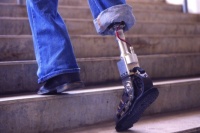Performance-enhancing Paralympic technology raises hopes and concerns
A new class of biohybrid prostheses will enable quicker running time.


A new class of biohybrid prostheses will enable quicker running time
Hugh Herr, director of the Biomechatronics Group at the MIT Media Lab, wants to create a prosthetic that could enable its user to run faster than Usain Bolt. He is pioneering research projects for a new class of biohybrid ’smart’ prostheses and believes the next century will blur the boundaries between man and machine.
One project involves a motorised ankle-foot prosthesis that provides active mechanical power. Its basic architecture is a unidirectional spring, configured in parallel with a force-controllable actuator that allows the ankle foot to match the size and weight of the human ankle.
Herr is now developing small, wireless implants that can be attached to muscles near the neuromuscular junction. In the longer term, he is researching the possibility of directly attaching a foot prosthesis to an amputee’s residual limb bone.
Register now to continue reading
Thanks for visiting The Engineer. You’ve now reached your monthly limit of premium content. Register for free to unlock unlimited access to all of our premium content, as well as the latest technology news, industry opinion and special reports.
Benefits of registering
-
In-depth insights and coverage of key emerging trends
-
Unrestricted access to special reports throughout the year
-
Daily technology news delivered straight to your inbox










Pipebots Transforming Water Pipe Leak Detection and Repair
Fantastic application.